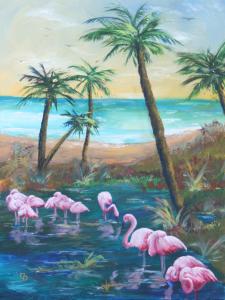Looking for design inspiration? Browse our curated collections!
July 11th, 2014 - 12:37 PM

The summer I created this painting, I really wanted a vacation at the beach. It was horribly hot that summer in Fresno; we had 20 days of 100o+ weather and I was so tired of it! Alas, money and my husbandís business (pool cleaners donít take vacations in the summer) conspired against me. Instead, I created my own beach, populated by those consummate beachcombers, the Flamingo.
I have always found Flamingos charming. Really, they are not a very pretty bird except for their color with their huge beak and stilt-like legs, but somehow they charm. They look silly too. Flamingos often stand on one leg, the other tucked beneath the body. I was very surprised to discover that they are only pink because of the food they eat! Adults range from light pink to bright red due to bacteria and beta-Carotene obtained from their food supply. Captive flamingos often turn only a pale pink, as they are not fed carotene at levels comparable to what they could find in the wild. That ugly beak has a reason: it is specially adapted to separate mud and silt from the food they eat and to be used upside-down.
Flamingos are very social birds; they live in colonies whose population can number in the thousands. These large colonies are believed to serve three purposes for the flamingos: avoiding predators, maximizing food intake, and using scarce suitable nesting sites more efficiently. Flamingoes form strong pair bonds of one male and one female. Unlike some members of the bird family who mate for life, in the larger colonies, flamingos sometimes do change mates probably because there are more mates to choose from.
Comments
There are no comments on this blog. Click here to post the first comment.